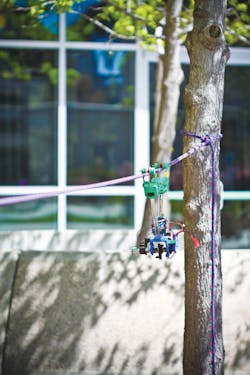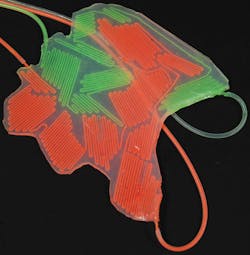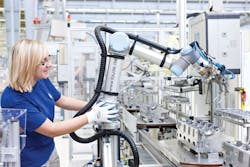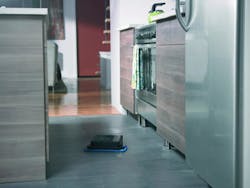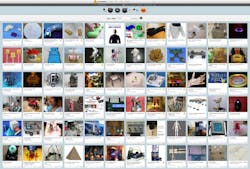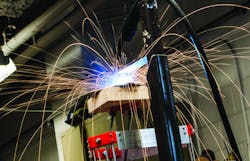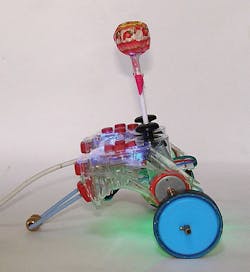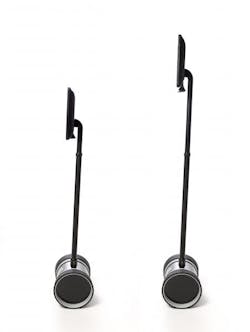Technology forecast 2014: Robots priced for the masses
Low-cost robots are an emerging breed of homemade, consumer, and light-industrial machines that execute modest tasks. The tools making cost-effective robots possible are new design approaches, low-cost kits, lightweight quick-build frames, open-source controls, forgiving actuators, and new techniques to manufacture linkages, including 3D printing.
In fact, non-industrial robots are getting better at executing modest to moderately complicated tasks and their numbers are on the rise thanks to new design approaches, open-source controls and hardware, forgiving actuators, and 3D-printed linkages.
Today’s robots fall into three basic categories.
At the top of the hierarchy are traditional industrial robots, powerful Scara and Cartesian machines that quickly and precisely move payloads to 1,000 kg or more. These expensive robots automate complex manufacturing tasks, most notably in the automotive industry. Lightweight Delta (parallel) robots have made inroads over the last decade, particularly in packaging applications, but most of these rely on proprietary and costly position controls.
Next are professional-grade service robots, with the term “service” denoting use outside of heavy manufacturing. This motley bunch comes in myriad forms and sizes and includes everything from robotic arms that assist doctors in surgery to remote-controlled submarines that image ocean trenches. Only about 8% of professional service robots are used for medical applications, but these multimillion-dollar machines account for more than 40% of this robot sector’s total value. But the category also includes lower-cost demolition, inspection, rescue, and light-assembly robots such as Rethink Robotics’ Baxter, which are economically automating tasks done manually until now. According to the Frankfurt, Germany-based International Federation of Robotics (IFR), known for the International Symposium on Robotics, manufacturers worldwide currently sell 16,000 professional-grade service robots every year (valued at $3.4 billion) and 94,800 more could be installed by the end of 2016.
This soft robot was built by Harvard engineers out of silicone. Pumps fill the channels with fluid and stiffen and release the arms to propel the unit along. Colored fluids can camouflage the bot. Production versions could cost just a few dollars and eliminate the tethers by incorporating the pump and its power supply.
The third tier of robots constitutes a skittering swarm of consumer, research, and educational robots, including everything from compact prosthetics and commercially available Roombas to robot kits and student-built crawlers. About 22 million personal-use service robots will be sold in the next three years because it has become more economical to mass-produce automatons. It’s also easier than ever for researchers and DIY engineers to craft one-off prototypes.
In contrast with industrial and professional-grade service robots, these small machines typically move payloads of a few kilograms at most. Consumers worldwide currently buy about three million personal robots worth $1.2 billion yearly, and that figure is expected to grow 20% to 50% annually, according to the IFR. Many are mass-produced bots for cleaning, lawnmowing, entertainment, and research.
Pro-grade thrifty bots
One third of all professional service robots are for defense applications and another quarter (believe it or not) milk cows in the dairy industry. Many military robots are unmanned aerial vehicles (UAVs).
Here, even the Dept. of Defense is exploring cheaper options: At the Association for Unmanned Vehicle Systems International (AUVSI) Washington conference last August, Maj. Gen. James Barclay described the Army’s new investment in “affordable bird-like microdrones” that soldiers can carry and launch by hand — including 36 2.5-lb UAVs from Prioria Robotics that reach speeds to 63 mph. The compact design and use of some off-the-shelf subcomponents, including select items for vision-based control and image processing, reduces cost to about half that of previous surveillance UAVs.
Related Articles
- Arduino, Raspberry Pi or BeagleBone?
- Cheaper swarming robots of 2011
- The inexpensive Kilobot
- Video: Telepresence robot
Another case in point: The Defense Advanced Research Projects Agency (DARPA) Autonomous Robotic Manipulation (ARM) program, in conjunction with Roomba-maker iRobot, Bedford, Mass., has cut the cost of heavyweight hand-type manipulators from more than $10,000 to less than $3,000 in just a few years. The iRobot hand uses compliant actuators that change the robotic-motion problem from one of positioning to one of force control and allows use of less expensive feedback.
Little wonder that Gill Pratt, professor of electrical and computer engineering at Olin College, Needham, Mass., is currently on loan to DARPA and managing the ARM and Maximum Mobility and Manipulation (M3) programs. He developed the most widespread compliant actuators, series elastic actuators (SEAs), at the MIT Leg Lab with engineer Matt Williamson in the 1990s. SEAs are traditional motor-powered actuators fitted to a load with a spring in between. They give robots built-in compliance for terrain navigation and energy storage. Williamson is now at Rethink, and its Baxter uses myriad SEAs.
“When we developed the SEA, high-fidelity force sources were expensive,” explains Pratt. “Engineers were designing low-friction gears for high precision, and others were improving cable transmissions, as found in some of today’s robotic prosthetics, but their designs still cost hundreds of thousands of dollars. Part of our idea was that for robots to really be effective and help society, they must be of low enough cost that most anyone can buy and use them.”
Besides SEAs, magnetorheological fluids, shape-metal alloys, and fluidic muscles can drive low-cost soft robots. Consider the blubbery silicone crawler from DARPA's M3 researchers at Harvard University. Pumps fill and drain tiny zigzagging channels in the robot’s legs with fluid to stiffen and release them. The pulses move the robot up to 67 m/hr and maneuver it through constrained spaces. Production versions could cost just a few dollars.
In fact, similar DIY soft-robot designs based on the idea of fluidic muscles abound on Autodesk Inc.’s instructables.com.
“I’m really pleased at how compliant actuators have taken off,” says Pratt, “but I’m not surprised. Williamson and I always believed that compliant actuators are a good choice for low-cost adaptive robots.”
Open software
Product distribution centers could soon be invaded by low-cost robots as well. A survey of Google Inc.’s 2013 robotics acquisitions suggests the company is banking on it. About 10% of all new professional service robots (not including self-guided vehicles) currently go into logistic systems. Google’s Meka and Redwood Robotics build SEA-based arms with manageable price points, and Holomni and Industrial Perception make controllable robot casters and machine vision and smarts, respectively.
All leverage at least some open controls that integrate on Robot Operation System (ROS) software, middleware that runs on operating systems such as Windows and Linux. ROS usually communicates using TCP/IP to handle control, process, actuator, and feedback data, among other things. ROS that runs on Java (promoted at ROS.org and by the Open Source Robotics Foundation) works on the Android platform, suggesting that ROS cofounder Ken Conley (now at Google) could lead a project customizing low-cost ROS-friendly robots with Google’s informational and navigational functions and communications.
In fact, tools like ROS blur the lines between professional and consumer-grade robots. Consider the lightweight robot arm developed through Robai of Energid Technologies Corp., Cambridge, that incorporates support for sophisticated ROS-enabled peripherals. In a recent Georgia Institute of Technology SMARTech talk, Energid CEO Neil Tardella explains how the affordable Actin arm can automate assembly tasks in electronics industries still done by hand in developing countries such as China. But it also lets users program the arm on a garden-variety personal computer through a USB port for setup that feels decidedly consumer.
Additive manufacturing brings down price
3D printing is also helping engineers build increasingly thrifty robots by reducing the manufacturing costs of their kinematic linkages.
Consider a robot built by engineers at the University of California, San Diego, to inspect utility lines for damage. Called the SkySweeper, it uses off-the-shelf electronics and 3D-printed plastic parts. A simple V-shaped kinematics linkage with a motor-driven elbow and clamps on the ends that open and close on power lines to inch the robot along. Production models could cost less than $1,000, far more economical than the large, complicated robots and infrared-fitted helicopters utility companies currently use to inspect lines. Future SkySweepers could carry induction coils to harvest energy from the power line itself, enabling them to work for weeks or months at a time. They could also incorporate cameras to transmit images to inspection crews.
Where plastic linkages won’t work, engineers at Michigan Technological University, Houghton, Mich., have created a 3D metal printer that costs about $1,500. It could be a tool for makers and researchers to custom manufacture linkages for low-cost robots with higher payload ratings.
Discounts for makers
Millions of low-cost hobby and “maker” robots and kits sell annually, with those for entertainment — think of the goofy mechanical bugs on radioshack.com and thinkgeek.com — alone worth $525 million. Millions more will be sold for education and research in coming years, and it’s no wonder, as more than 140 U.S. universities now have dedicated robotics programs.
To support these curricula, manufacturers donate components and support through FIRST sponsorships and independent initiatives, including industrial-component manufacturers. For example, igus inc., Fisher Connectors, Harmonic Drive, and maxon Precision Motors support the Roboticists, Engineers & Manufacturers Consortium (REM-C) nonprofit that supplies universities with discounted components, technical support, and internship spots.
Mass-produced kits also abound, and Mindstorms from LEGO Education N.A., Pittsburg, Kans., have led the charge. For lower-cost alternatives, Jameco Electronics, Belmont, Calif., (through robotstore.com) and Parallax Inc., Rocklin, Calif., (through digikey.com) sell educational kits that let makers design their own. RoadNarrows sells more advanced kits and components, many programmable in ROS. A large online community also supports exploration with robot kits from Arduino, Ivrea, Italy, known for its open-source electronics hardware and software. Arduino sells hundreds of thousands of these kits each year, and Arduino-based creations have only proliferated as students and gadget inventors alike build small-scale inventions on Arduino boards and clones, peripherals, and related pieces of open-source software.In contrast with multimillion-dollar surgery robots used in hospitals, a new breed of medical homecare and mobility-assistance robots are modestly priced. Consider the $2,500 telepresence robot from Double Robotics, Sunnyvale, Calif., that already lets healthcare professionals remotely check on patients. (Read Telepresence robot gives me wicked case of the giggles for how to drive one of these.)
The robots use self-balancing motor-powered wheels to move and garden-variety iPads for the interactive interface — another example of low-cost robots integrating off-the-shelf components to reduce costs.
Though there aren’t many of these homecare robots yet, their numbers should rise dramatically over coming decades. Likewise, not many robotic prosthetics and assistance robots are economical, but research groups worldwide are currently developing cost-effective disabled-assistance designs.
About the Author
Elisabeth Eitel
Elisabeth Eitel was a Senior Editor at Machine Design magazine until 2014. She has a B.S. in Mechanical Engineering from Fenn College at Cleveland State University.

